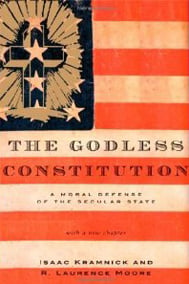The Godless Constitution: A Moral Defense of the Secular State, by Isaac Kramnick and R. Laurence Moore. New York: W. W. Norton & Company, 2005. 210 pp. $15.95 (paperback).

We often hear claims that America is a “Christian nation” and that “the Constitution was designed to perpetuate a Christian order” (James Dobson). Are such claims correct? If not, how does one show it? If America is a secular nation, how can one convince ignorant but active-minded people of this truth?
Toward answering these questions, The Godless Constitution: A Moral Defense of the Secular State by Isaac Kramnick and R. Laurence Moore is a good place to start. Though not without flaws, it offers a fascinating and valuable history of the relationship between church and state in America.
Originally published in 1996, this book has been updated twice, the last time in 2005. Chapter 1 surveys the contemporary stage, with ample quotations of prominent Christian leaders and their claims of America’s Christian identity. Chapter 2 reviews the content of the Constitution regarding religion, noting among other things that it never refers to a god. This chapter also offers an overview of debates and discussions on the religious content of the Constitution at the time it was framed.
The next three chapters are concerned with the root ideas, both secular and religious, that enabled the founders to formulate their winning arguments, focusing mainly on the ideas of Roger Williams, John Locke, and Thomas Jefferson.
In relating the story of Roger Williams, the authors offer a potent argument for Christians who may not have considered that religion can be harmed by a religion-wielding government.
A Puritan minister who arrived in Massachusetts in 1631, Williams witnessed the local government dictating religious orthodoxy. He criticized this practice, agitated against it, and was subsequently banished from Salem in 1636. He then settled in Rhode Island, where he founded the Narragansett Bay Colony.
Williams’s reason for wanting government out of religion is interesting: He regarded the practice of government dictating religion as an exploitation of God. As a student of history, he saw the trend moving backward to pre-Reformation times, when men had to “lie down and creep” as before the pope’s outstretched ring. Whereas the church governs spiritual matters, he said, political government should be “merely human and civil.” In short, he argued, the church must not be sullied by involvement in government.
The chapters on the English roots of the secular state and on Thomas Jefferson summarize America’s philosophic heritage, highlighting Enlightenment thought and its influence on the Constitution. These chapters illuminate the Enlightenment view that the government is properly concerned only with civil matters and that spiritual matters are outside its province.
Chapter 6 addresses the history and influence of the American Baptists, who were ardent supporters of church-state separation in early America. Baptist beliefs challenged Puritan practice, so Baptists had good reason to oppose government establishment of religion: Their freedom of conscience (and that of the many minority sects in America at the time) depended on government not favoring any one Christian sect.
In Chapter 7 Kramnick and Moore describe two major movements in American History: the Sunday Mail controversy (1810–1912) and the push to add a Christian Amendment to the Constitution (1863–1954). These controversies lasted decades, so each gives a window on American thinking over a substantial period. Reading about the substance of the debates, it becomes clear that while many Americans fully understood the importance of the separation of church and state, many others sought to legislate their religious values.
The Sunday Mail controversy began in 1810, when Congress passed a law mandating mail movement and delivery seven days a week. Calls for a repeal of this law began at once and lasted for more than a century. Especially in the first fifty years of the debate, articulate spokesmen for separation prevailed with powerful arguments that the government has no right “to coerce the religious homage of anyone” (p. 141, quoting from Richard M Johnson’s 1829 Report on the Subject of Mails on the Sabbath). In 1912, congressional legislation closed all post offices still open on Sunday.
There were two “Christian Amendments” proposed during a prolonged push to have the Constitution recognize Jesus Christ as supreme ruler and divine law as primary. The first was drafted in 1863, the second in 1947. They would have established Christianity (while naming no particular sects) as the official religion of the United States.
The final two chapters are updates to the original book. Here we see that whereas the authors’ observed only fifteen years ago (during the Clinton years) that “Christian candidates are encouraged to play down a moral agenda while running for office” (p. 159), they now observe that George W. Bush was the first president to define himself by his religious faith, a trend that many politicians continue today.
But it is also in these final two chapters (and to some extent in the first chapter) that the main flaws of the book are found. The authors inconsistently apply the trove of historical ideas they expose, and they rest their own ideas about the role of government on altruist premises. For example, they sanction government support for some faith-based charities (p. 193) and locally mandated aid to religious schools for the secular courses they teach (p. 15). They caution against “overzealousness in defending Jefferson’s wall” of separation (p. 191).
And they write: “Whatever their differences, moral Americans have communal responsibilities toward people who suffer from poverty and disease and ignorance” (p. 191).
Even so, The Godless Constitution provides a fascinating historical recounting of the secular ideas behind the founding of America, including important truths for those fighting for complete separation of church and state.


![[TEST] The Objective Standard](https://test.theobjectivestandard.com/wp-content/uploads/2017/10/logo.png)













